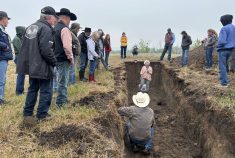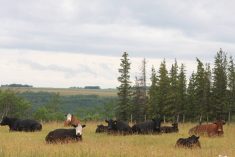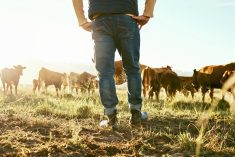You’ve probably read the story of the Siege of Troy, or at least watched the movie with Brad Pitt. If not, here is a summary: Queen Helen of Sparta absconded with or was abducted by Paris. They sailed back to his hometown of Troy. Her husband, King Menelaus, was displeased and roped his friends Odysseus and Achilles into a war with Troy. The people of Troy withstood the siege for a decade until clever Odysseus came up with the idea to construct a giant wooden horse, fill it with soldiers, and wheel it to the city gates as a “gift” before pretending to leave. The Trojans fell for the ruse, and Odysseus and his friends won the war (although it then took Odysseus another lifetime to get home).
Ranchers and farmers looking to expand herds by buying cows might want to consider this tale, too. For example, a pregnant cow that appears perfectly healthy could be carrying bovine viral diarrhea (BVD). The BVD virus can transfer across the placenta, says Dr. Cheryl Waldner, and if that calf is infected at the wrong time during gestation, it may become a super-shedder and remain infected for life. Such a calf is unlikely to live past the age of two or three years old, but by then, BVD may have laid waste to your ranch, just like the city of Troy.
Waldner is the research chair in One Health and production-limiting diseases at the Western College of Veterinary Medicine. She’s concerned not only about BVD, but other diseases such as vibrio (also known as campylobacter), trichomoniasis and infectious bovine rhinotracheitis (IBR) sneaking into herds. BVD and IBR can be spread through direct contact or the environment and can sicken animals and cause sudden deaths. But the biggest losses are usually abortions and open cows. The others are typically spread during the breeding season.
Read Also

The Canadian Cattle Association’s international advocacy efforts
Global ag policies affect Canadian food policy, so the Canadian Cattle Association participates in international and domestic forums
So just how bad can these reproductive wrecks get? Waldner says sometimes the consequences are subtle — a bump in abortion rates and open cows. Often in those cases, the herd has been exposed to the disease before or been vaccinated against the disease. But over the years, she’s also seen pregnancy rates as low as 20 or 30 per cent. Yes, pregnancy rates, not cull rates.
“It doesn’t always hit like that. But it can and when it does, it can be a game changer for an operation.”
Along with the fetuses of pregnant cows, younger animals can also be at higher risk for bringing in BVD, Waldner says. But for vibrio and trich, mature bulls are the higher-risk animals.
“The problem with these older bulls is, once they get infected, they’re often infected for life. It can be difficult to consistently detect the infection in them, but it can be hiding there. And it can end up causing disease, even several years down the road.”
Yearling or 18-month bulls (so-called “virgin” bulls) are usually a safer bet as they’re less likely to have picked up a disease from the breeding season. But even young bulls aren’t guaranteed to be disease-free.
“We all know how well bulls like to stay in fences,” Waldner says.
Testing is an option, but it costs money and can be logistically difficult to arrange. However, it might be worth thinking about for high-value animals or some high-risk situations. For example, the test for BVD is “pretty good,” simple and “relatively inexpensive,” says Waldner, and it’s worth considering if one is worried about persistently infected animals. Tests for trich and vibrio, on the other hand, are imperfect and need to be done two or three times in high-risk animals. Three negative trich results, two or three weeks apart, mean a person can be “pretty sure” that an animal is trich-free, but it’s still not 100 per cent.
Talking to the seller about disease history in the herd is also a good idea, Waldner says. Ask whether they keep herd records, track abortions and pregnancy rates, and preg check.
“Herds that do all of these things and have those records are usually pretty happy to share some numbers with you. And if there’s a really strong history of good reproductive performance in the herd that you’re buying from, that’s at least a level of assurance that the risk is lower than buying from a herd where that information is completely unknown.”
Producers can also take a page from community pastures that require cows to have a calf at foot. Those cows are “probably a pretty safe bet,” says Waldner, adding producers shouldn’t bring in open cows. Consider culling cows that don’t produce a live calf instead of keeping them for another year.
“Cows are more effective at clearing most of these infections than bulls are. But it’s not 100 per cent, so there is still some potential risk there.”
Quarantining won’t help with diseases such as trich, vibrio or for animals with a persistent BVD infection. But it can help with IBR, as that disease has clinical signs, and is over quickly.
Vaccines are also an option for some situations. Waldner says there is “very good evidence” from western Canadian field trials for the IBR and BVD vaccines in high-risk cattle. Producers in high-risk situations should talk to their veterinarians about these vaccines. Leptospirosis, a bacterial disease, can also hitch a ride with purchased cattle. An “aggressive, well-timed, well-managed vaccine program” can make a big difference with that disease as well. There’s also a vaccine for vibrio, although Waldner says there’s less known about the effectiveness of that vaccine, so it’s best to discuss your situation with a vet. Dr. Ron Clarke also discusses this vaccine in his Vet Advice column in our September 2023 issue. Unfortunately, for trich, there’s no vaccine in Canada.
My interview with Dr. Cheryl Waldner will be available as a podcast this fall on our new Herd Health page. The page will also include other interviews about common cattle diseases and vaccine management and articles on these topics.
















